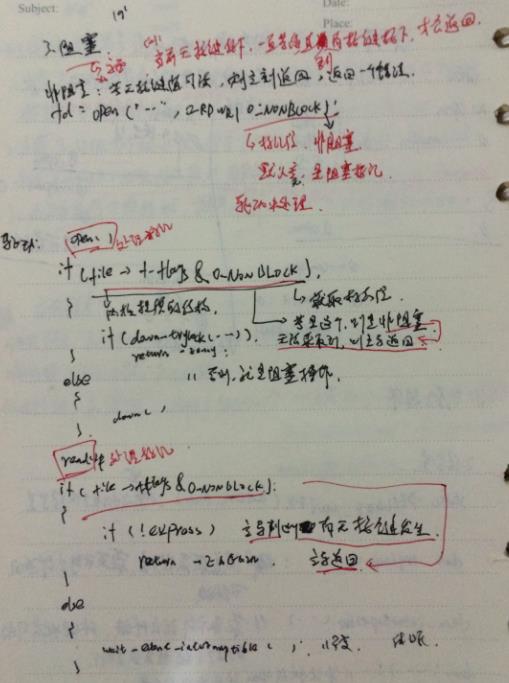linux 原子操作能用在中断中吗
Posted
tags:
篇首语:本文由小常识网(cha138.com)小编为大家整理,主要介绍了linux 原子操作能用在中断中吗相关的知识,希望对你有一定的参考价值。
参考技术A 中断里只要不睡眠即可,因为中断上下文不能调度,而原子操作不会等待 肯定会返回一个结果 要么执行要么不执行 所以不会睡眠 参考技术B 不能。不能中断。要么执行,要么不执行。 参考技术C 不能中断的,亲 ,要么继续 要么就关机...Linux之同步互斥阻塞20160703
主要介绍一下Linux下的互斥与阻塞方面的知识:
1. 原子操作
原子操作指的是在执行过程中不会被别的代码路径所中断的操作。
常用原子操作函数举例:
atomic_t v = ATOMIC_INIT(0); //定义原子变量v并初始化为0
atomic_read(atomic_t *v); //返回原子变量的值
void atomic_inc(atomic_t *v); //原子变量增加1
void atomic_dec(atomic_t *v); //原子变量减少1
int atomic_dec_and_test(atomic_t *v); //自减操作后测试其是否为0,为0则返回true,否则返回false。
2. 信号量
信号量(semaphore)是用于保护临界区的一种常用方法,只有得到信号量的进程才能执行临界区代码。
当获取不到信号量时,进程进入休眠等待状态。
定义信号量
struct semaphore sem;
初始化信号量
void sema_init (struct semaphore *sem, int val);
void init_MUTEX(struct semaphore *sem);//初始化为0
static DECLARE_MUTEX(button_lock); //定义互斥锁
获得信号量
void down(struct semaphore * sem);
int down_interruptible(struct semaphore * sem);
int down_trylock(struct semaphore * sem);
释放信号量
void up(struct semaphore * sem);
3. 阻塞
阻塞操作
是指在执行设备操作时若不能获得资源则挂起进程,直到满足可操作的条件后再进行操作。
被挂起的进程进入休眠状态,被从调度器的运行队列移走,直到等待的条件被满足。
非阻塞操作
进程在不能进行设备操作时并不挂起,它或者放弃,或者不停地查询,直至可以进行操作为止。
fd = open("...", O_RDWR | O_NONBLOCK);
示例代码:
1.应用程序:
#include <sys/types.h>
#include <sys/stat.h>
#include <fcntl.h>
#include <stdio.h>
#include <poll.h>
#include <signal.h>
#include <sys/types.h>
#include <unistd.h>
#include <fcntl.h>
/* sixthdrvtest
*/
int fd;
void my_signal_fun(int signum)
{
unsigned char key_val;
read(fd, &key_val, 1);
printf("key_val: 0x%x\\n", key_val);
}
int main(int argc, char **argv)
{
unsigned char key_val;
int ret;
int Oflags;
//signal(SIGIO, my_signal_fun);
fd = open("/dev/buttons", O_RDWR | O_NONBLOCK);
if (fd < 0)
{
printf("can\'t open!\\n");
return -1;
}
//fcntl(fd, F_SETOWN, getpid());
//Oflags = fcntl(fd, F_GETFL);
//fcntl(fd, F_SETFL, Oflags | FASYNC);
while (1)
{
ret = read(fd, &key_val, 1);
printf("key_val: 0x%x, ret = %d\\n", key_val, ret);
sleep(5);
}
return 0;
}
2.驱动程序:
#include <linux/module.h>
#include <linux/kernel.h>
#include <linux/fs.h>
#include <linux/init.h>
#include <linux/delay.h>
#include <linux/irq.h>
#include <asm/uaccess.h>
#include <asm/irq.h>
#include <asm/io.h>
#include <asm/arch/regs-gpio.h>
#include <asm/hardware.h>
#include <linux/poll.h>
static struct class *sixthdrv_class;
static struct class_device *sixthdrv_class_dev;
volatile unsigned long *gpfcon;
volatile unsigned long *gpfdat;
volatile unsigned long *gpgcon;
volatile unsigned long *gpgdat;
static DECLARE_WAIT_QUEUE_HEAD(button_waitq);
/* 中断事件标志, 中断服务程序将它置1,sixth_drv_read将它清0 */
static volatile int ev_press = 0;
static struct fasync_struct *button_async;
struct pin_desc{
unsigned int pin;
unsigned int key_val;
};
/* 键值: 按下时, 0x01, 0x02, 0x03, 0x04 */
/* 键值: 松开时, 0x81, 0x82, 0x83, 0x84 */
static unsigned char key_val;
struct pin_desc pins_desc[4] = {
{S3C2410_GPF0, 0x01},
{S3C2410_GPF2, 0x02},
{S3C2410_GPG3, 0x03},
{S3C2410_GPG11, 0x04},
};
//static atomic_t canopen = ATOMIC_INIT(1); //定义原子变量并初始化为1
static DECLARE_MUTEX(button_lock); //定义互斥锁
/*
* 确定按键值
*/
static irqreturn_t buttons_irq(int irq, void *dev_id)
{
struct pin_desc * pindesc = (struct pin_desc *)dev_id;
unsigned int pinval;
pinval = s3c2410_gpio_getpin(pindesc->pin);
if (pinval)
{
/* 松开 */
key_val = 0x80 | pindesc->key_val;
}
else
{
/* 按下 */
key_val = pindesc->key_val;
}
ev_press = 1; /* 表示中断发生了 */
wake_up_interruptible(&button_waitq); /* 唤醒休眠的进程 */
kill_fasync (&button_async, SIGIO, POLL_IN);
return IRQ_RETVAL(IRQ_HANDLED);
}
static int sixth_drv_open(struct inode *inode, struct file *file)
{
#if 0
if (!atomic_dec_and_test(&canopen))
{
atomic_inc(&canopen);
return -EBUSY;
}
#endif
if (file->f_flags & O_NONBLOCK)
{
if (down_trylock(&button_lock))
return -EBUSY;
}
else
{
/* 获取信号量 */
down(&button_lock);
}
/* 配置GPF0,2为输入引脚 */
/* 配置GPG3,11为输入引脚 */
request_irq(IRQ_EINT0, buttons_irq, IRQT_BOTHEDGE, "S2", &pins_desc[0]);
request_irq(IRQ_EINT2, buttons_irq, IRQT_BOTHEDGE, "S3", &pins_desc[1]);
request_irq(IRQ_EINT11, buttons_irq, IRQT_BOTHEDGE, "S4", &pins_desc[2]);
request_irq(IRQ_EINT19, buttons_irq, IRQT_BOTHEDGE, "S5", &pins_desc[3]);
return 0;
}
ssize_t sixth_drv_read(struct file *file, char __user *buf, size_t size, loff_t *ppos)
{
if (size != 1)
return -EINVAL;
if (file->f_flags & O_NONBLOCK)
{
if (!ev_press)
return -EAGAIN;
}
else
{
/* 如果没有按键动作, 休眠 */
wait_event_interruptible(button_waitq, ev_press);
}
/* 如果有按键动作, 返回键值 */
copy_to_user(buf, &key_val, 1);
ev_press = 0;
return 1;
}
int sixth_drv_close(struct inode *inode, struct file *file)
{
//atomic_inc(&canopen);
free_irq(IRQ_EINT0, &pins_desc[0]);
free_irq(IRQ_EINT2, &pins_desc[1]);
free_irq(IRQ_EINT11, &pins_desc[2]);
free_irq(IRQ_EINT19, &pins_desc[3]);
up(&button_lock);
return 0;
}
static unsigned sixth_drv_poll(struct file *file, poll_table *wait)
{
unsigned int mask = 0;
poll_wait(file, &button_waitq, wait); // 不会立即休眠
if (ev_press)
mask |= POLLIN | POLLRDNORM;
return mask;
}
static int sixth_drv_fasync (int fd, struct file *filp, int on)
{
printk("driver: sixth_drv_fasync\\n");
return fasync_helper (fd, filp, on, &button_async);
}
static struct file_operations sencod_drv_fops = {
.owner = THIS_MODULE, /* 这是一个宏,推向编译模块时自动创建的__this_module变量 */
.open = sixth_drv_open,
.read = sixth_drv_read,
.release = sixth_drv_close,
.poll = sixth_drv_poll,
.fasync = sixth_drv_fasync,
};
int major;
static int sixth_drv_init(void)
{
major = register_chrdev(0, "sixth_drv", &sencod_drv_fops);
sixthdrv_class = class_create(THIS_MODULE, "sixth_drv");
sixthdrv_class_dev = class_device_create(sixthdrv_class, NULL, MKDEV(major, 0), NULL, "buttons"); /* /dev/buttons */
gpfcon = (volatile unsigned long *)ioremap(0x56000050, 16);
gpfdat = gpfcon + 1;
gpgcon = (volatile unsigned long *)ioremap(0x56000060, 16);
gpgdat = gpgcon + 1;
return 0;
}
static void sixth_drv_exit(void)
{
unregister_chrdev(major, "sixth_drv");
class_device_unregister(sixthdrv_class_dev);
class_destroy(sixthdrv_class);
iounmap(gpfcon);
iounmap(gpgcon);
return 0;
}
module_init(sixth_drv_init);
module_exit(sixth_drv_exit);
MODULE_LICENSE("GPL");
最后附笔者学习笔记:


以上是关于linux 原子操作能用在中断中吗的主要内容,如果未能解决你的问题,请参考以下文章